The West
After the Civil War, America turned westward with the approaching completion of the transcontinental railroad. An army of railroad engineers, surveyors, and photographers participated in the effort to join the Union Pacific and the Central Pacific railroads, finally linking the east and west coasts.
Photographing the West using the state-of-the-art wet plate collodion process was a daunting task. A photographer would often require a half dozen men and a team of mules just to carry the chemicals and heavy glass plates on which the images were captured. For each exposure a plate was coated with wet collodion emulsion, placed in a camera, exposed, and then developed on site, in the wilderness, before the emulsion had time to dry.
Among the photographers who met the challenge were men like Alexander Gardner and Timothy O’Sullivan, both of whom had honed their skills as part of Mathew Brady’s photographic corps on the battlefields of the Civil War. William Henry Jackson, a young painter and former Union soldier, took photographs that helped convince Congress to make Yellowstone the first National Park in 1872. In his 1895 history of Yellowstone, Hiram Martin Chittenden wrote, “The photographs were of immense value … Description might exaggerate, but the camera told the truth; in this case the truth was more remarkable than exaggeration… and doubtless convinced everyone who saw that the region where such wonders existed should be carefully preserved to the public forever.”
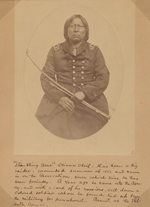 |
William S. Soule. Setimkia (Stumbling Bear), Kiowa Chief, 1869-1874. [zoom] Albumen print, 6 x 4 1/2 in. William Soule (1832-1935) made an important series of Native American portraits at Fort Sill, Oklahoma. Stumbling Bear (1832-1903) was an influential Kiowa war chief who later advocated peace with the whites. The contemporary annotation tells that Stumbling Bear “... came into the Agency, and, with a band of his warriors, cut down a colored soldier whom he found tied up by the military for punishment.” |
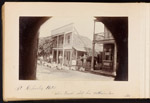 |
J. Green & Son. Album of the California Gold Country, ca. 1888. [zoom] Albumen prints, 4 1/2 x 7 3/4 in. |
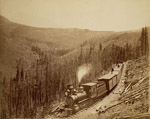 |
William Henry Jackson. Marshall Pass Railroad, ca. 1880. [zoom] Albumen print, 16 1/4 x 21 in. A train delivers new materials for the extension of the line at Marshall Pass, Colorado. This dramatic image captures the steel, telegraph lines, steam power, and felled trees heralding the simultaneously creative and destructive force of the railroad in the American West. |
 |
Carelton E. Watkins. Portland, Oregon, 1880s. [zoom] Albumen print, 4 ¾ x 7 3/4 in. In this panorama of Portland, Oregon, Watkins documents the rapid development of the Pacific Northwest. In 1890 the superintendent of the U.S. Census declared the American Western frontier was closed, and a new era had begun. |
 |
A. C. Murphy. “Rocky Mountain Viewing” Photography Wagon, ca. 1889. [zoom] Albumen print, carte de visite mount On loan from the Stephan and Beth Loewentheil Family Photographic Collection. |
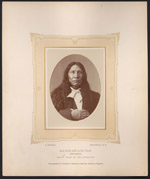 |
Alexander Gardner. Maȟpíya Lúta (Red Cloud), Oglala Lakota Chief (Sioux), May 1872. [zoom] Albumen print, 5 1/4 x 3 7/8 in. A formidable opponent of the United States Army, Red Cloud (1822-1909) led the Oglalala Lakota in Red Cloud’s War in 1866-1868. Gardner made this portrait during Red Cloud’s 1872 visit to Washington D.C. where he met with President Ulysses S. Grant to negotiate treaties. Red Cloud played a key role in the transition to reservation life after the 1868 Treaty of Fort Laramie. |
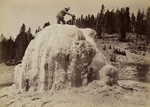 |
William Henry Jackson. Crater of the Lone Star Geyser, Yellowstone National Park, ca. 1878. [zoom] Albumen print, 9 1/4 x 13 in. Jackson (1843-1942) was a member of the Hayden Geological Surveys, which were annual multidisciplinary expeditions meant to chart the largely unexplored west. As a prominent member of the survey, Jackson was in the position to capture the first photographs of legendary landmarks of the West. The surveys greatly influenced the creation of Yellowstone National Park, the first National Park in the United States. |